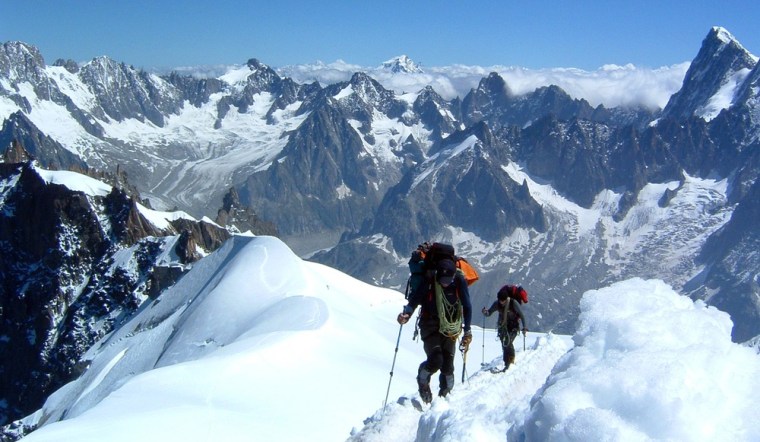One of my favorite winter memories happened one night on the snowy slopes of the Berner Oberland in Switzerland. My friend Walter and I, warmed by hot chocolate laced with schnapps, decided to go sledding between mountain-high villages. We strapped flashlights to our heads, miner-style, and zoomed through the crisp, moonlit night.
When people think of winter in Europe, many picture the Swiss Alps — swooshing down dramatic slopes; tramping through quaint, cobbled villages with snow blanketing chalet rooftops; or snuggling around a pot of fondue with loved ones.
These images are why Switzerland's ski resorts are understandably popular. They also offer an astounding variety of terrain, relatively mild temperatures, a lively apres-ski scene — and activities for non-extreme types, including snowshoeing, sledding, ice-skating, shopping, and sightseeing.
My favorite destination in Switzerland — winter or summer — is the Berner Oberland, with the grand old resort town of Interlaken as its gateway. This area in central Switzerland offers the ultimate diversity of terrain, good snow on its higher runs, reasonable prices, and character that's missing in many swankier resort areas.
The cliff-hanging town of Murren is relatively uncrowded and a good home base for expert skiers, with the 10,000-foot Schilthorn peak as its backbone. Across the valley, Wengen has skiing for all skill levels and a rental shop run by the family of Olympic skier Karl Molitor. Grindelwald, a little closer to Interlaken, has more than 100 miles of downhill trails, including the area's best range of beginners' runs. You can even swish with the Swiss down a 9-mile-long sledding run — the world's longest.
At 11,300 feet, the Jungfraujoch in the Berner Oberland is Europe's highest train station. The hour-long train ride takes you from Kleine Scheidegg, up the notorious North Face of the Eiger Mountain, then through a tunnel inside the Eiger. At the top, you can visit a cavern of ice statues or ride an elevator up to the Sphinx observatory to view the Aletsch Glacier — Europe's longest, at nearly 11 miles.
The town of Zermatt in southern Switzerland lies in the shadow of the Matterhorn. Zermatt's high elevation and variety of runs — and the chance to actually ski or snowboard from Switzerland to Italy — make it deservedly popular. For classic Matterhorn views, ride the lift at Rothorn.
In southeast Switzerland, ritzy St. Moritz is a high-end shopper's paradise — and overly glamorous for my taste. It's also home to a museum displaying the works of Giovanni Segantini, the ultimate painter of alpine life, whose pieces are reminiscent of the French Impressionists. For more action, try a game of polo and cricket on snow, go bobsledding on natural ice, or check out skijoring — skiing while being pulled by riderless horses. Or you can ride up a lift, rent a chair in the sun, and warm up with a glass of Pflumli (plum liqueur).
The perfect end to the day is a fondue dinner, featuring a communal pot of melted cheese. For the Swiss, fondue is a purely winter specialty (only tourists eat it in summer). It's served with a wonderful Swiss white wine called Fendant. When Swiss plan a cozy party, they add "FIGUGEGL" (fee-GOO-geck-ul) to the invitation — "Fondu isch guet und git e gueti Lune" ("Fondue is good and gives a good mood"). According to tradition, if you drop your bread into the pot, you must kiss the person to your left.
Though Switzerland may be the most well-known winter destination, the scene can be just as good elsewhere. The Dolomites in northern Italy are popular for the Sella Ronda, in which intrepid skiers circle the Sella massif using a system of lifts and 28 miles of ski runs.
The Savoie region of France, centered around 15,771-foot Mont Blanc, feels more Swiss than French, with wood chalets overflowing with geraniums and fondue in every restaurant. Chamonix, the largest of five villages at the base of Mont Blanc, offers some of the best expert-level skiing in the world, jaw-dropping views, and a good balance between true mountaineer culture and touristy glitz. Non-skiers can go dog-sledding or hike along groomed winter footpaths.
Innsbruck, in Austria's western panhandle, is surrounded by 150 mountain lifts. Hosts of the 1964 and 1976 Winter Olympics, it offers the rare chance to careen down an Olympic bobsled course — a 4,000-foot-long track covered with ice. For a superb view overlooking the city, head out to the Bergisel, where a modern ski jump stands in the same location as the original one that was used for both Olympics.
While most travelers visit Europe in the warmer months, a trip here in winter can be just as memorable. Whether your sport is skiing, snowboarding, or simply enjoying the good life, Europe's cozy mountain villages may just have the cure for the winter blues.
( writes European travel guidebooks and hosts travel shows on public television and public radio. E-mail him at , or write to him c/o P.O. Box 2009, Edmonds, Wash. 98020.)
